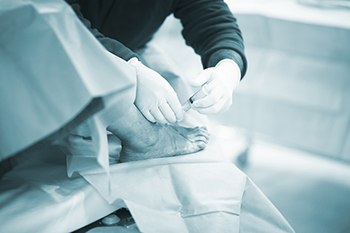Douglas Pacaccio, DPM
Thomas Nordquist, DPM
October 2021
Why Is My Child Limping?
Kohler’s Disease, which typically occurs in children between 3 and 7 years of age, is a rare bone disease which affects the tarsal navicular bone in the foot. This boat-shaped bone connects the ankle with the lower bones in the feet. In Kohler’s Disease, this bone suddenly loses its blood supply causing it to degenerate. The child usually feels pain and tenderness along the arch and there may be swelling and redness. It is popularly believed that Kohler’s disease may be caused by strain or injury to the navicular and its blood vessels before the bone becomes completely hardened. The good news is that the navicular bone usually recovers and regains its density, size, and structure within time. However, until such time, the child may limp or walk on the side of the affected foot to compensate for the pain they experience while walking. A podiatrist can diagnose Kohler disease in your child and ease their pain with special supportive shoes and, or orthotics, casting, and pain relievers.
Making sure that your children maintain good foot health is very important as they grow. If you have any questions, contact one of our podiatrists of Advanced Foot and Ankle Surgeons, Inc. . Our doctors can provide the care you need to keep you pain-free and on your feet.
Keeping Children's Feet Healthy
Having healthy feet during childhood can help prevent medical problems later in life, namely in the back and legs. As children grow, their feet require different types of care. Here are some things to consider...
Although babies do not walk yet, it is still very important to take care of their feet.
Avoid putting tight shoes or socks on his or her feet.
Allow the baby to stretch and kick his or her feet to feel comfortable.
As a toddler, kids are now on the move and begin to develop differently. At this age, toddlers are getting a feel for walking, so don’t be alarmed if your toddler is unsteady or ‘walks funny’.
As your child gets older, it is important to teach them how to take care of their feet.
Show them proper hygiene to prevent infections such as fungus.
Be watchful for any pain or injury.
Have all injuries checked by a doctor as soon as possible.
Comfortable, protective shoes should always be worn, especially at play.
If you have any questions please feel free to contact one of our offices located in Sycamore, and Yorkville, IL . We offer the newest diagnostic and treatment technologies for all your foot and ankle needs.
Arthroscopy: A Technological Marvel
In arthroscopic surgery, a small incision in the skin is made to allow a narrow instrument (arthroscope)—with a light and video camera attached—to be inserted into the ankle. The video from the camera transmits a signal to a large screen which the surgeon views to see and diagnose damage inside the ankle. The surgeon can look at this video to guide them during arthroscopic surgery, using tiny surgical instruments inserted through other small incisions. Arthroscopic ankle surgery can be used to restore damage to cartilage, remove bone spurs, scar tissue and debris, and treat certain conditions in the small area at the back of the ankle. Arthroscopic surgery offers shorter hospital stays and recovery time, and it has a lower risk of infection due to small incisions being made—as opposed to larger incisions associated with open surgeries. Make an appointment with your podiatrist to see if arthroscopic surgery is appropriate for your ankle condition.
Foot surgery is sometimes necessary to treat a foot ailment. To learn more, contact one of our podiatrists of Advanced Foot and Ankle Surgeons, Inc. . Our doctors will assist you with all of your foot and ankle needs.
When Is Surgery Necessary?
Foot and ankle surgery is generally reserved for cases in which less invasive, conservative procedures have failed to alleviate the problem. Some of the cases in which surgery may be necessary include:
- Removing foot deformities like bunions and bone spurs
- Severe arthritis that has caused bone issues
- Cosmetic reconstruction
What Types of Surgery Are There?
The type of surgery you receive will depend on the nature of the problem you have. Some of the possible surgeries include:
- Bunionectomy for painful bunions
- Surgical fusion for realignment of bones
- Neuropathy decompression surgery to treat nerve damage
Benefits of Surgery
Although surgery is usually a last resort, it can provide more complete pain relief compared to non-surgical methods and may allow you to finally resume full activity.
Surgical techniques have also become increasingly sophisticated. Techniques like endoscopic surgery allow for smaller incisions and faster recovery times.
If you have any questions please feel free to contact one of our offices located in Sycamore, and Yorkville, IL . We offer the newest diagnostic and treatment technologies for all your foot and ankle needs.
Abnormal Gaits
An abnormal gait is a dysfunctional walking pattern. It typically occurs due to biomechanical problems win the feet and ankles. In a normal gait, the feet both spend roughly an equal amount of time in contact with the ground. Many patients complain of a painful (antalgic) gait. This type of gait is usually due to a foot or ankle injury. The patient avoids bearing weight on the injured foot, resulting in an altered gait with shorter strides and an inequality in the amount of time each foot spends in contact with the ground (with the injured foot on the ground less). A high steppage gait is a walking pattern characterized by bending the knee more than is normal while walking. Patients do this to compensate for weak anterior compartment muscles, which can cause their foot to drop or slap onto the ground. If you have an abnormal gait, it is strongly suggested that you see a podiatrist for diagnosis and treatment.
If you have any concerns about your feet, contact one of our podiatrists from Advanced Foot and Ankle Surgeons, Inc. . Our doctors can provide the care you need to keep you pain-free and on your feet.
Biomechanics in Podiatry
Podiatric biomechanics is a particular sector of specialty podiatry with licensed practitioners who are trained to diagnose and treat conditions affecting the foot, ankle and lower leg. Biomechanics deals with the forces that act against the body, causing an interference with the biological structures. It focuses on the movement of the ankle, the foot and the forces that interact with them.
A History of Biomechanics
- Biomechanics dates back to the BC era in Egypt where evidence of professional foot care has been recorded.
- In 1974, biomechanics gained a higher profile from the studies of Merton Root, who claimed that by changing or controlling the forces between the ankle and the foot, corrections or conditions could be implemented to gain strength and coordination in the area.
Modern technological improvements are based on past theories and therapeutic processes that provide a better understanding of podiatric concepts for biomechanics. Computers can provide accurate information about the forces and patterns of the feet and lower legs.
Understanding biomechanics of the feet can help improve and eliminate pain, stopping further stress to the foot.
If you have any questions please feel free to contact one of our offices located in Sycamore, and Yorkville, IL . We offer the newest diagnostic and treatment technologies for all your foot and ankle needs.
Reminder: When Was the Last Time...?
Understanding Gout
Gout is a type of inflammatory arthritis where excess amounts of uric acid causes hard crystals to form in the joints—most commonly affected is the big toe joint. The body’s inability to flush uric acid may be caused by kidney disease, diabetes, high blood pressure, obesity, certain medications, consuming foods and beverages that are high in purines, and a family history of gout. The pain felt by gout can often be acute, and may be accompanied by a burning sensation, swelling, and severe tenderness in the big toe. A podiatrist can diagnose gout through an examination, blood tests and analysis of joint fluid, and create a treatment plan based on their findings and the severity of the condition in the patient.
Gout is a foot condition that requires certain treatment and care. If you are seeking treatment, contact one of our podiatrists from Advanced Foot and Ankle Surgeons, Inc. . Our doctors will treat your foot and ankle needs.
What Is Gout?
Gout is a type of arthritis caused by a buildup of uric acid in the bloodstream. It often develops in the foot, especially the big toe area, although it can manifest in other parts of the body as well. Gout can make walking and standing very painful and is especially common in diabetics and the obese.
People typically get gout because of a poor diet. Genetic predisposition is also a factor. The children of parents who have had gout frequently have a chance of developing it themselves.
Gout can easily be identified by redness and inflammation of the big toe and the surrounding areas of the foot. Other symptoms include extreme fatigue, joint pain, and running high fevers. Sometimes corticosteroid drugs can be prescribed to treat gout, but the best way to combat this disease is to get more exercise and eat a better diet.
If you have any questions please feel free to contact one of our offices located in Sycamore, and Yorkville, IL . We offer the newest diagnostic and treatment technologies for all your foot and ankle needs.
Blog Archives
- April 2024
- March 2024
- February 2024
- January 2024
- December 2023
- November 2023
- October 2023
- September 2023
- August 2023
- July 2023
- June 2023
- May 2023
- April 2023
- March 2023
- February 2023
- January 2023
- December 2022
- November 2022
- October 2022
- September 2022
- August 2022
- July 2022
- June 2022
- May 2022
- April 2022
- March 2022
- February 2022
- January 2022
- December 2021
- November 2021
- October 2021
- September 2021
- August 2021
- July 2021
- June 2021
- May 2021
- April 2021
- March 2021
- February 2021
- January 2021
- December 2020
- November 2020
- October 2020
- September 2020
- August 2020
- July 2020
- June 2020
- May 2020
- April 2020
- March 2020
- February 2020
- January 2020
- December 2019
- November 2019
- October 2019
- September 2019
- August 2019
- July 2019
- June 2019
- May 2019
- April 2019
- March 2019
- February 2019
- January 2019
- December 2018
- November 2018
- October 2018
- September 2018













